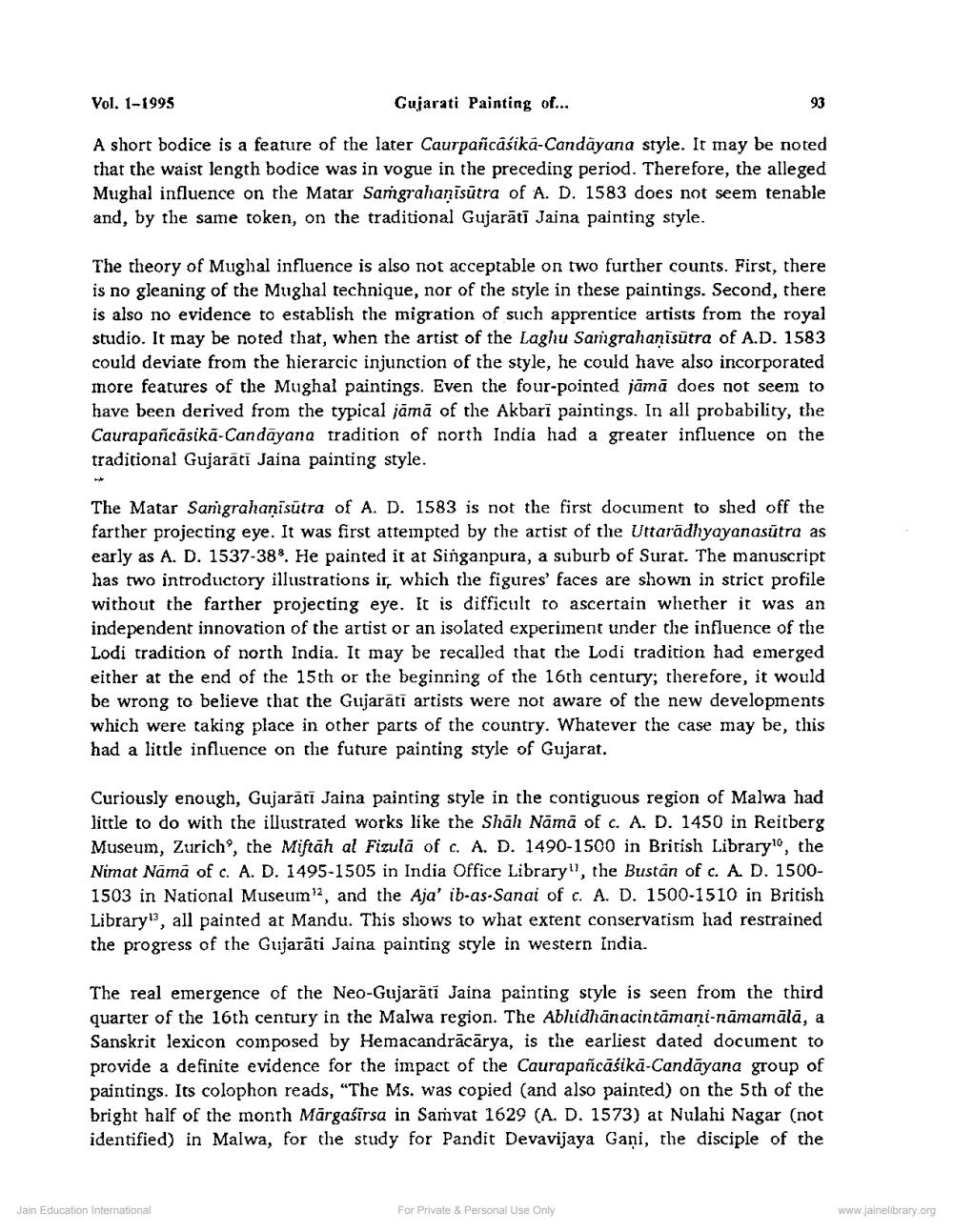Book Title: Gujarati Painting of 16th 17th Century Author(s): Lalit Kumar Publisher: Z_Nirgrantha_1_022701.pdf and Nirgrantha_2_022702.pdf and Nirgrantha_3_022703.pdf View full book textPage 2
________________ Vol. 1-1995 Gujarati Painting of... 93 A short bodice is a feature of the later Caurpañcasika-Candāyana style. It may be noted that the waist length bodice was in vogue in the preceding period. Therefore, the alleged Mughal influence on the Matar Samgrahanīsūtra of A. D. 1583 does not seem tenable and, by the same token, on the traditional Gujarātī Jaina painting style. The theory of Mughal influence is also not acceptable on two further counts. First, there is no gleaning of the Mughal technique, nor of the style in these paintings. Second, there is also no evidence to establish the migration of such apprentice artists from the royal studio. It may be noted that, when the artist of the Laghu Sanigrahanisutra of A.D. 1583 could deviate from the hierarcic injunction of the style, he could have also incorporated more features of the Mughal paintings. Even the four-pointed jāmā does not seem to have been derived from the typical jāmā of the Akbari paintings. In all probability, the Caurapañcāsikā-Candayana tradition of north India had a greater influence on the traditional Gujarati Jaina painting style. The Matar Sanigrahaņisutra of A. D. 1583 is not the first document to shed off the farther projecting eye. It was first attempted by the artist of the Uttarādhyayanasūtra as early as A. D. 1537-38% He painted it at Singanpura, a suburb of Surat. The manuscript has two introductory illustrations ir, which the figures' faces are shown in strict profile without the farther projecting eye. It is difficult to ascertain whether it was an independent innovation of the artist or an isolated experiment under the influence of the Lodi tradition of north India. It may be recalled that the Lodi tradition had emerged either at the end of the 15th or the beginning of the 16th century; therefore, it would be wrong to believe that the Gujarāti artists were not aware of the new developments which were taking place in other parts of the country. Whatever the case may be, this had a little influence on the future painting style of Gujarat. Curiously enough, Gujarati Jaina painting style in the contiguous region of Malwa had little to do with the illustrated works like the Shah Namā of c. A. D. 1450 in Reitberg Museum, Zuricho, the Miftah al Fizulā of c. A. D. 1490-1500 in British Library, the Nimat Nāmā of c. A. D. 1495-1505 in India Office Library!!, the Bustān of c. A. D. 15001503 in National Museum, and the Aja' ib-as-Sanai of c. A. D. 1500-1510 in British Library'), all painted at Mandu. This shows to what extent conservatism had restrained the progress of the Gujarati Jaina painting style in western India. The real emergence of the Neo-Gujarātī Jaina painting style is seen from the third quarter of the 16th century in the Malwa region. The Abhidhānacintāmani-namamālā, a Sanskrit lexicon composed by Hemacandrācārya, is the earliest dated document to provide a definite evidence for the impact of the Caurapañcāśikā-Candāyana group of paintings. Its colophon reads, “The Ms. was copied (and also painted) on the 5th of the bright half of the month Mārgaśīrsa in Samvat 1629 (A. D. 1573) at Nulahi Nagar (not identified) in Malwa, for the study for Pandit Devavijaya Gaņi, the disciple of the Jain Education International For Private & Personal Use Only www.jainelibrary.orgPage Navigation
1 2 3 4 5 6 7 8 9 10 11 12 13 14 15 16 17 18
